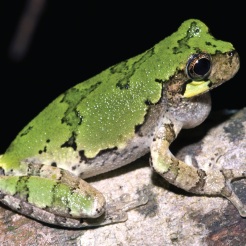Wild Thing is an occasional series where JHU Press authors write about the flora and fauna of the natural world—from the rarest flower to the most magnificent beast.
Guest post by C. Kenneth Dodd Jr.
I cannot say when I saw my first frog, but I must have been very young. I grew up in northern Virginia surrounded by fields and forests that have since been paved over by asphalt and concrete. This semi-rural environment provided me with a wealth of habitats to explore. I remember listening to singing American Toads and catching Southern Leopard Frogs along the creek near my house. I always knew I wanted to study zoology.
I attended the University of Kentucky to learn about cave biology, but in my vertebrate zoology and herpetology classes I was introduced to the amphibian world. What fascinating animals these were that sometimes lived so secretively among us: the diversity, the color, and the intriguing life histories—so much to learn! By the time I started graduate school, I was ready to immerse myself in the science surrounding these creatures, not with an initial intent to conduct basic research, but simply to know more about them. After graduation, a short teaching stint, and years with the U.S. Endangered Species Program as staff herpetologist, I moved to a research position in Florida and was again able to chase frogs under the guise of making a living. In retrospect, my career has been a fortunate one, for despite occasional setbacks and aggravation, I have been able to pursue natural history and spend much time in unique places doing interesting research with insightful colleagues who became friends. Through herpetology, I have tried to make sense of how even a small portion of nature works.
Early rambles through the creeks and woodlands started me on a long journey that has taken me to six continents, fifty states, three Canadian provinces, and many Caribbean islands. At every turn I have found frogs, and each place has left its own special memories: listening to Bird-voiced Treefrogs in a Mississippi swamp with fireflies arching through the tree canopy, trying to photograph a large aquatic frog in Kenya and suddenly and emphatically realizing I was lying on an ant mound, searching unsuccessfully for gastric-brooding frogs in Australia’s tropical rainforest, finding rare frogs in the Seychelles Islands in the Indian Ocean under a starry sky with fruit bats squawking in the trees, finding Scutiger (a Himalayan frog) tadpoles at 5,000 m. in Tibet and foam-nesting Rhacophorus (an Asian treefrog) in Taiwan, and seeing my first dart-poison frogs hopping through the leaf litter in Costa Rica. I still get a thrill from seeing a Barking Treefrog or hearing the soft chirping of Greenhouse Frogs around my natural yard in Florida.
Frogs are truly gentle animals. As my New Zealand colleagues have inscribed on their t-shirts, “Fact: The survival of the Earth depends on frogs.” Today, frogs are at a greater peril worldwide from human activity than at any time in recent geologic history. I hope that Frogs of the United States and Canada stimulates an interest in and appreciation of frogs, along with a desire to study and conserve them before many of these species disappear from our land- and soundscapes.
 C. Kenneth Dodd Jr. is an associate professor (courtesy) in the Department of Wildlife Ecology and Conservation, University of Florida, and is a former president of the Herpetologists’ League. He is the author of Frogs of the United States and Canada, published by JHU Press.
C. Kenneth Dodd Jr. is an associate professor (courtesy) in the Department of Wildlife Ecology and Conservation, University of Florida, and is a former president of the Herpetologists’ League. He is the author of Frogs of the United States and Canada, published by JHU Press.



